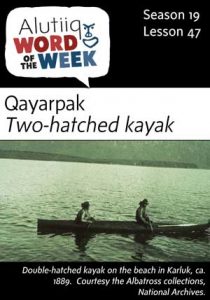From the Arctic Ocean to Prince William Sound, Native people crafted swift, seaworthy boats from wood and animal skins. Each culture had a distinct style of qayaq with unique qualities designed for their environment. Alutiiq qayat were long and slender, built to withstand the rough, windy waters of the North Pacific Ocean. But not all qayat were the same. Like modern American cars, there were different types of boats designed for different purposes.
The qayanguaq, or single single-hatched qayaq was the sports car of the past. These swift, boats could be used for any purpose, from fishing to traveling, but they were especially useful for pursuing fast-swimming sea mammals like porpoise and whales.
In contrast, hunters used double-hatched–or qayarpak–for team hunting. The man in the front hatch hurled weapons while the man in the rear steadied and steered the qayat. These spacious boats were also useful for family travel, like a station wagon. Mom and dad paddled with children and supplies tucked under the deck. Elder Natalie Simeonoff remembered traveling from Woody Island to Eagle Harbor inside her family’s qayaq, with their chickens!
There were also triple-hatched qayat, or paitalek. Alutiiq people began making three-person boats in the Russian era. A large hatch in the center held a Russian trader, smaller hatches in the bow and stern provided seats for Native paddlers. These large boats could carry quantities of gear, like a pickup truck!
Source: Alutiiq Museum [xyz-ihs snippet=”Adsense-responsive”]

 Qayarpak – Two-hatched kayak
Qayarpak – Two-hatched kayak